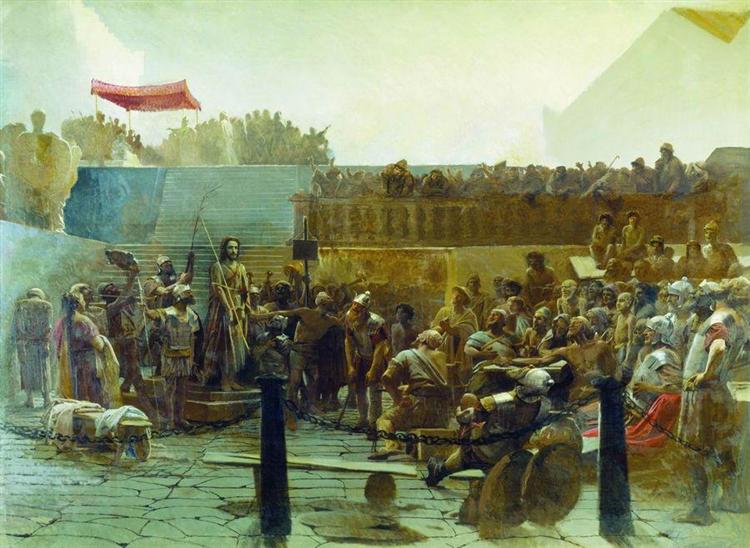Kramskoy Ivan – “Laughter”
The continuation of the theme of Christ was the monumental painting Laughter. As Kramskoy’s letters to Fyodor Vasiliev testify, it was conceived back in 1872, after the end of Christ in the Wilderness: “We must also write Christ; not his own, but the crowd that laughs with all the might of their huge animal lungs. ” Kramskoy worked on the painting until the end of his life, but he could not finish it, which the artist experienced as the most painful creative failure of his life. The theme of conscience, readiness for self-sacrifice is replaced in this work by the theme of blasphemously ridiculed suffering for an idea, mockery of the truth. “While we are not seriously chatting about goodness, honesty, we are in harmony with everyone – try to seriously implement your ideas, see what laughter will rise around. I hear this laughter everywhere. They still continue to laugh at Him, building altars at the same time, “wrote Kramskoy. In this picture, he expressed both the pessimistic experience of the generation of the sixties, and the collapse of their hopes. “Laughter is the answer to deeds, to beliefs that make up the task and goal of all life. Laughter is a punishment for daring to consider oneself smarter than those whom he thought to see wandering in ignorance. ” Laughter – for everything that is high and beautiful, does not look like vulgarity, self-righteousness and inertia. Christ exposed to ridicule. What is crucifixion to him? What is death? But this Laughter! He was unable to get rid of him. “
The idea of Laughter turned out to be stronger and more interesting than its execution. The space of the picture resembles the stage of an opera stage. The figure of Christ is lost among the crowd of soldiers. Kramskoy could not cope with the task of creating a multi-figured monumental canvas.
Nevertheless, this picture did not pass without leaving a trace for Russian art. Its right side, with laughing warriors and a foreground figure falling out on the viewer, served as a canvas for Repin’s composition of the painting “The Cossacks are Writing a Letter to the Turkish Sultan.” Kramskoy’s unsuccessful painting was also “nourishing” for Ge’s work. His painting “What is Truth?” can be viewed as the implementation of the concentrated idea of ”Laughter” by Kramskoy, the idea of mockery of the truth. Ge seemed to “cleanse” Kramskoy’s plan of unnecessary figures, leaving only Christ and Pilate. Christ Ge is the development of the image of the humble in suffering, frail in body, but invulnerable in the spirit of Christ from Kramskoy’s Laughter.
Year of painting: 1877 – 1882.
Dimensions of the painting: 373 x 501 cm.
Material: canvas.
Writing technique: oil.
Genre: religious painting.
Style: realism.
Gallery: State Russian Museum, St. Petersburg, Russia.
